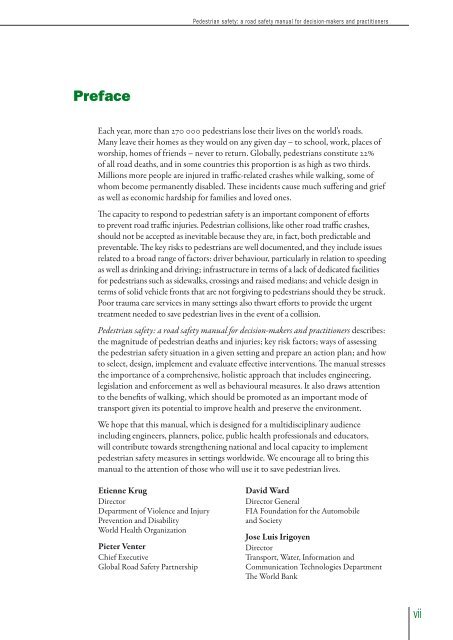Pedestrian safety - Global Road Safety Partnership
Pedestrian safety - Global Road Safety Partnership
Pedestrian safety - Global Road Safety Partnership
You also want an ePaper? Increase the reach of your titles
YUMPU automatically turns print PDFs into web optimized ePapers that Google loves.
<strong>Pedestrian</strong> <strong>safety</strong>: a road <strong>safety</strong> manual for decision-makers and practitioners<br />
Preface<br />
Each year, more than 270 000 pedestrians lose their lives on the world’s roads.<br />
Many leave their homes as they would on any given day – to school, work, places of<br />
worship, homes of friends – never to return. <strong>Global</strong>ly, pedestrians constitute 22%<br />
of all road deaths, and in some countries this proportion is as high as two thirds.<br />
Millions more people are injured in traffic-related crashes while walking, some of<br />
whom become permanently disabled. These incidents cause much suffering and grief<br />
as well as economic hardship for families and loved ones.<br />
The capacity to respond to pedestrian <strong>safety</strong> is an important component of efforts<br />
to prevent road traffic injuries. <strong>Pedestrian</strong> collisions, like other road traffic crashes,<br />
should not be accepted as inevitable because they are, in fact, both predictable and<br />
preventable. The key risks to pedestrians are well documented, and they include issues<br />
related to a broad range of factors: driver behaviour, particularly in relation to speeding<br />
as well as drinking and driving; infrastructure in terms of a lack of dedicated facilities<br />
for pedestrians such as sidewalks, crossings and raised medians; and vehicle design in<br />
terms of solid vehicle fronts that are not forgiving to pedestrians should they be struck.<br />
Poor trauma care services in many settings also thwart efforts to provide the urgent<br />
treatment needed to save pedestrian lives in the event of a collision.<br />
<strong>Pedestrian</strong> <strong>safety</strong>: a road <strong>safety</strong> manual for decision-makers and practitioners describes:<br />
the magnitude of pedestrian deaths and injuries; key risk factors; ways of assessing<br />
the pedestrian <strong>safety</strong> situation in a given setting and prepare an action plan; and how<br />
to select, design, implement and evaluate effective interventions. The manual stresses<br />
the importance of a comprehensive, holistic approach that includes engineering,<br />
legislation and enforcement as well as behavioural measures. It also draws attention<br />
to the benefits of walking, which should be promoted as an important mode of<br />
transport given its potential to improve health and preserve the environment.<br />
We hope that this manual, which is designed for a multidisciplinary audience<br />
including engineers, planners, police, public health professionals and educators,<br />
will contribute towards strengthening national and local capacity to implement<br />
pedestrian <strong>safety</strong> measures in settings worldwide. We encourage all to bring this<br />
manual to the attention of those who will use it to save pedestrian lives.<br />
Etienne Krug<br />
Director<br />
Department of Violence and Injury<br />
Prevention and Disability<br />
World Health Organization<br />
Pieter Venter<br />
Chief Executive<br />
<strong>Global</strong> <strong>Road</strong> <strong>Safety</strong> <strong>Partnership</strong><br />
David Ward<br />
Director General<br />
FIA Foundation for the Automobile<br />
and Society<br />
Jose Luis Irigoyen<br />
Director<br />
Transport, Water, Information and<br />
Communication Technologies Department<br />
The World Bank<br />
vii






